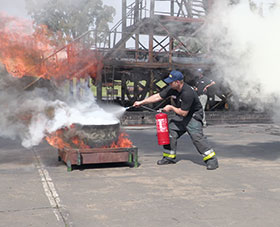

Recent tests conducted by Sasol and I-CAT have proven conclusively that dry chemical powder extinguishers are ineffective against rubber fires and conveyor belt and tyre fires, both encountered in underground mining. This means that many underground mines have little or no fire protection, posing a major health and safety risk to mineworkers.
In addition, activating a dry chemical powder extinguisher in a confined space underground can result in an inhalation risk for operators and bystanders. The dry chemical powder can also contaminate the air-circulation system underground, and further erode mechanical and electrical parts on machinery, causing long-term damage.
“To enhance the productivity of a mine, new technology is the main driver to make it more efficient at a lower total cost, which ultimately increases profitability. However, fire safety has lacked in technological advances, as it is mostly seen as a ‘grudge purchase’ that impacts on the bottom line,” says Andro Gibhard from the I-CAT Fire Division.
“Fire protection should be the first port of call for any mining operation, as the main aim is to preserve human life, without even referring to the financial and economic impact when a fire results in production downtime. It is therefore imperative that fire risk should be a primary focus when it comes to mining safety.”
The I-CAT Fire Division recently conducted a series of tests at a Sasol facility to determine the effectiveness of water and foam mist systems on underground conveyor belts on coal mines. Since most fire-fighting products deployed in the mining industry originate from Europe and the US, the question arises as to whether or not these have been tested for mining conditions in Africa.
“During the tests, it was discovered that widely-accepted equipment failed badly. What then is the effectiveness in an underground mining scenario, where conditions are less favourable?” Gibhard asks.
In terms of its ongoing contribution to improved fire-fighting methodologies for the mining industry, the I-CAT Fire Division has compiled a new protection protocol for underground conveyor belt protection, including redundancy protection. The protocol has been tested against various test scenarios identified in a risk assessment.
Solutions available from the I-CAT Fire Division include its TRT-LPS-FM system, an acronym for T-Rotor Technology – Local Protection System – Foam Mist. T-Rotor Technology is the internationally-patented low-pressure mist system.
This includes protection for conveyor belts (drive, take-up, and tail-end), hydraulic power packs, transformers, and generators. These are all stored-water pressure systems, which means that an external water connection is not needed in order for them to be operational.
For more information contact I-CAT, 0861 124 228, [email protected], www.i-cat.co.za

© Technews Publishing (Pty) Ltd. | All Rights Reserved.